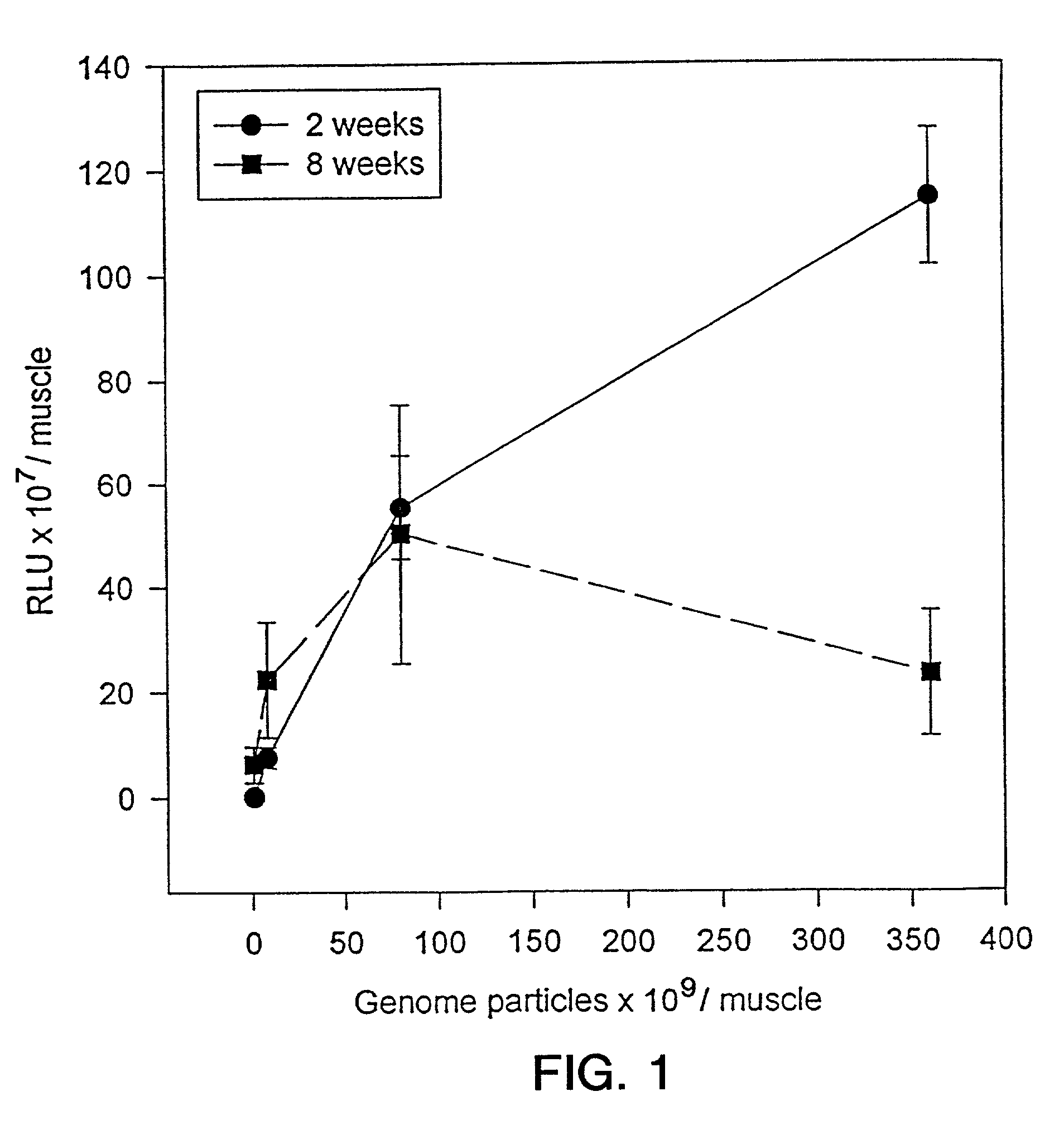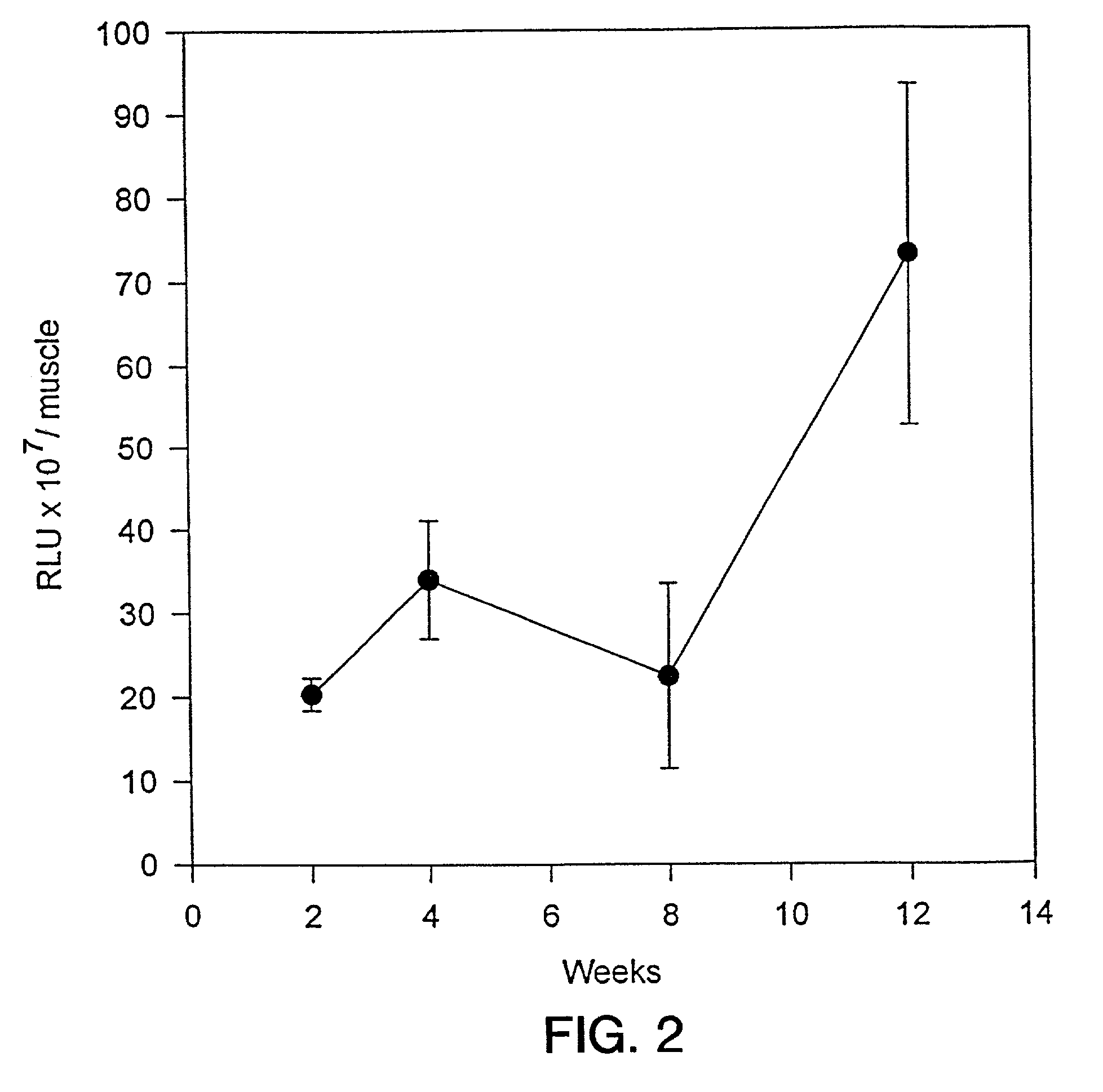Methods for delivering DNA to muscle cells using recombinant adeno-associated virus vectors
a technology of adeno-associated virus and a delivery method, which is applied in the direction of viruses, drug compositions, enzymology, etc., can solve the problems of reducing the life of the transduced cell, low expression levels, and ineffective long-term gene therapy, and achieve the effect of efficient delivery of genes
- Summary
- Abstract
- Description
- Claims
- Application Information
AI Technical Summary
Benefits of technology
Problems solved by technology
Method used
Image
Examples
example 1
Dose-Response of rAAV-LacZ Vector in Balb / c Mice
[0130]To determine the effective dose range for the rAAV-LacZ vector in vivo, vector was injected into the tibialis anterior muscle of 6–8 week old healthy Balb / c mice, and transduction assessed by β-gal activity measured by Galacto-Light™ relative light units (RLU). Two weeks post-injection, the range of RLU is from approximately 0.2×107 RLU / muscle with 8×108 vector genomes to approximately 1.1×109 RLU / muscle with 3.6×1011 injected vector genomes (FIG. 1). The levels of expression of β-gal measured by RLU correspond to the percentage of β-gal positive muscle fibers on cross-sectional analysis. For example, 0.2×107 RLU corresponds to approximately 1% β-gal positive muscle fibers; 1.1×109 RLU corresponds to approximately 60% β-gal positive muscle fibers. Expression of a gene delivered by a rAAV vector was approximately 10,000-fold greater than the same gene delivered by plasmid DNA. A comparison was made at two weeks post-injection of r...
example 2
Time Course of rAAV-LacZ Vector Expression In Vivo
[0131]Animals were followed after injection to determine the persistence of vector expression. For these experiments, animals were injected in the tibialis anterior muscle with 8×109 vector genome equivalents of rAAV-LacZ in 20 μl volume. Muscle was harvested at selected time points from 2 to 12 weeks and analyzed for total β-gal expression by Galacto-Light™ luminescence. As can be seen, the level of β-gal production increased over the time interval from 2 to 12 weeks post-injection (FIG. 2). These results demonstrate that rAAV-LacZ expression in muscle persisted for an interval of at least 12 weeks in vivo.
example 3
Comparison of Secretion of Erythropoietin from Myotubes or Myoblasts
[0132]Myotubes (differentiated C2C12 cells) or myoblasts (dividing C2C12 cells) were transduced in culture with the rAAV-hEPO vector to determine the feasibility of in vivo polypeptide secretion. Erythropoietin (EPO) was chosen because it has been shown to be secreted by muscle (Descamps et al. (1995) Gene Therapy 2:411–417; Hamamori et al. (1994) Hum. Gene Therapy 5:1349–1356; Hamamori et al. (1995) J. Clin. Invest. 95:1808–1813) and it has well defined biological effects. A comparison of the secretion of EPO from myotubes or myoblasts revealed that secretion of the hormone was observed in both populations. Additionally, the levels of 24 hour EPO secretion increased in the myotubes over the first seven days post-transduction (FIG. 3). These data demonstrate that gene transfer of rAAV-hEPO into either myotubes or myoblasts results in protein secretion.
PUM
| Property | Measurement | Unit |
|---|---|---|
| Therapeutic | aaaaa | aaaaa |
Abstract
Description
Claims
Application Information
 Login to View More
Login to View More - R&D
- Intellectual Property
- Life Sciences
- Materials
- Tech Scout
- Unparalleled Data Quality
- Higher Quality Content
- 60% Fewer Hallucinations
Browse by: Latest US Patents, China's latest patents, Technical Efficacy Thesaurus, Application Domain, Technology Topic, Popular Technical Reports.
© 2025 PatSnap. All rights reserved.Legal|Privacy policy|Modern Slavery Act Transparency Statement|Sitemap|About US| Contact US: help@patsnap.com



